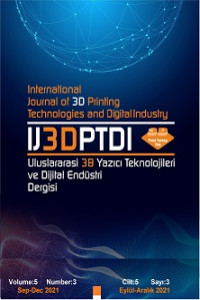Research Article
Issue Editorial Board

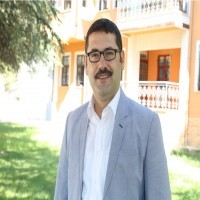
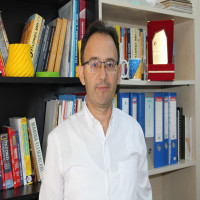
 0000-0001-5614-1556
0000-0001-5614-1556
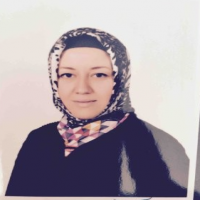
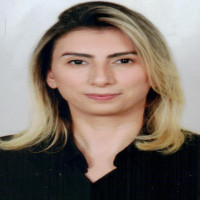

 0000-0001-8052-9411
0000-0001-8052-9411



Aim & Scope
The objective of the journal is to contribute to the development of the profession of 3 dimensional technologies (additive manufacturing) and digital industry at national and international leves.
Medical Applications for 3D Printing (Bioprinting tissues and organs, Challenges in building 3d vascularized organs, Customized implants and prostheses, Low–cost prosthetic parts, Anatomical models for surgical preparation, Synthetic skin, Cranium replacement, Medical equipment, Bone, Tailor-made sensors, Personalized drug dosing, Unique dosage forms, Complex drug-release profiles)
Aplication Fields (Medical and dental applications, Dental practices and materials, Soft robotics systems, Robot gripper systems, Building applications, Die/mold applications, Architecture applications, Models applications, Rapid prototype applications, Visual arts applications, Textile applications, Digital factories, Architectural-model applications and materials, Industrial applications and materials, Food applications and materials, Artistic practices and materials, Scanning methods and modeling)
Digital Industry (Big data, Artificial intelligence, Digital life cycles, Sensors actuators, Augmented reality, visualization, System simulation, Wireless communication, ICT security, Digital business, Block chain, Data Safety, Autonomous robots, System integration, Internet of things (IT’s), Cyber security, Cloud computing,Digital factory)
3D Printer Design, Modelling and Analysis (3D printer design, extruder design, Product development, Ceramic systems design, Food systems design Table system design, Electronics components, Mechanic components, Standard components)
Mechanical Properties of Filaments (Polymer materials, Flexible materials, Bio materials, Metallic materials, Wood materials, Composite materials)
Program – Control Technologies (Control programs, Design programs, 3D scanning technologies, DMLS technologies, SLA technologies, SLS technologies, FDM technologies, Digital production technologies,
Other 3D printer technologies and digital industry
Author Guidelines
INTERNATIONAL JOURNAL OF 3D PRINTING TECHNOLOGIES AND DIGITAL INDUSTRY
PREPARATION
Authors are required to download the template file (Please click here to download the template)
Click for the copyright form. (Please click here to download the copyright form)
PlAGIARISM FILE: Full Text of manuscript including references section should be scanned with "iThenticate" or "Turnitin" programs. The Plagiarism result you will receive from the relevant program must be uploaded to the system in PDF format.
A. INSTRUCTIONS TO AUTHORS
· The title page must be upper case in Times New Roman font size 14, and bold.
· All authors listed as the first name, and last name (i.e., Koray Özsoy1) without the highest academic or medical degree first.
· Authors names must be center as follows: (Times New Roman font size 10)
e.g., Koray Özsoy
· Institutional affiliation for each author must be as follows: (Times New Roman font size 10)
e.g., Xxxx University Engineering Faculty, Xxxx Department, İstanbul
· The abstract of the manuscript must be upper case as follows: (Times New Roman font size 12 and bold)
e.g., ABSTRACT
· The abstract of manuscript text must be in Times New Roman font size 11. If the abbreviation is used, the abbreviated of the name must be specified in parentheses.
· The aim of the study and method must be briefly stated, the findings must be summarized with sufficient numerical details and the results must be explained within the framework the presented findings.
· Introduction (clearly stating an objective or hypothesis), Methods (describing the study design and methods applied), Discussion and Results (describing the results of the study in context with the published literature and addressing study limitations) can be used within a structured abstract if desired.
· The abstract must not exceed 250 words.
· Please keep the confirmation messages to your e-mail address after the manuscript submission process.
· Please tell us the technical support and questions about the submission korayozsoy@sdu.edu.tr
B. ORIGINAL RESEARCH ARTICLES
B.1. Principles of Writing
· The manuscript must be up to 15 (fifteen) pages including references.
· No corrections will be made by the journal boards in the manuscript. For this reason, authors are responsible for the mistakes in spelling and meaning.
· Set your document as A4 (International Standard: ISO 216) paper, use single line spacing, Times New Roman font size 11, number all pages, do not justify the right margin, and use line numbers. Save your manuscript as a Word document (.doc, .docx, or previous) and the margins must be set to be 2.5 cm for all edges.
B.2. Writing rules
The manuscript must be structured as follows.
I. Abstract
At the beginning of the manuscript must be Turkish and English Abstract. The abstract of text is Times New Roman size 11 and must not exceed 250 words. Besides, the abstract of the manuscript must not only be sufficient to explain the aim of the study, but fully represent the content of the study briefly written and emphasize the important points or conclusions of the manuscript.
II. DIVISIONS and Subdivisions
The names of division must be the upper case but subdivisions must be written lower case. The text of divisions and subdivisions Times New Roman size 12, and bold.
e.g., 1. INTRODUCTION; 2. MATERIAL 3. METHOD……;
2.1. Used in the Study ….
Ill. Figures and Tables
· The text of figures must be written in the top, whereas the text of the table must be written on top, and the content of Figure/Table must be described as title next to the number. Figures/Tables must be placed in the text.
· The content of Figure / Table must be written Times New Roman size 10. It should only be bold as Figure 1. and Table 1.
lV. References
· References must follow the text and begin on a separate page.
· References must be double line spaced and numbered consecutively in order of appearance within the text, using the automated numbering tool of Word.
· All the references must be Times New Roman size 10 and take place inside the references.
· Identify references in text, tables, and legends in Arabic numerals in parentheses, i.e. (7).
· List all authors when six or fewer; when seven or more, list only the first three and add et al.
· References used within tables or figure legends should be included in the reference list and numbered in consecutive order according to the table/figure citation in the text.
Examples of reference style:
Examples of reference style:
Books
Authors, “Book Name ”, Pages.,Publishing, City, Year.
Example:
1. Baykasoğlu, A., Dereli, T., “Information technology methods in production”, Pages 254-255, Kırmızı Publishing, İstanbul, 2006.
Chapter in book
Authors, “Title”, Editors, Book Name, Pages, Publishing name, City, Year.
Example:
2. Williams, D.F., “Titanium for medical applications: titanium in medicine: material science, surface science, engineering, biological responses and medical applications”, In Brunette
DM, Tengvall P, Textor M et al editors, Titanium in medicine, Pages 13-24, Springer. Berlin, 2001.
Standard journal article
Authors, “Title of Manuscript ”, The name of Journal, Vol, No, Pages, Year.
Example:
3. Isaza Saldarriaga, J.F., Correa Vélez, S., Cumplido Posada, A., Bedoya Henao, B., Torres Valencia, C.A., “Design and manufacturing of a custom skull implant”, American Journal of
Engineering and Applied Sciences, Vol. 4, Issue 1, Pages 169-174, 2011.
4. Delikanlı, K., Sofu, M.M., Bekçi, U., “Üretim sektöründe hızlı direkt imalat sistemlerinin yeri ve önemi” [Place and Importance of Rapid Direct Manufacturing Systems in
Manufacturing Sector] [article in Turkish], Makine Teknolojileri Elektronik Dergisi, Cilt 4, Sayı 1, Sayfa 33-39, 2006.
Thesis
Author, “Title of Thesis ”, Type of Thesis, University, City, Year.
Example:
5. Özuğur, B., “Hızlı prototipleme teknikleri ile kompleks yapıdaki parçaların üretilebilirliklerinin araştırılması”, Yüksek Lisans Tezi, [The investigation of manufacturability of parts
having a complex structure by rapid prototyping technologies] [Thesis in Turkish], Gazi Üniversitesi, Ankara, 2006.
Academic paper
Authors, “Title of paper ”, Symposium Name, Pages , City, Year.
Example:
6. Kayacan, M.C., Özsoy, K., Kor, Ö., “Endüstri devrimi 4.0”, 2rd International Symposioum on 3D Printing Technologies, Sayfa 120-128, İstanbul, 2007.
Online-only reference
Authors, “The title of the web”, Accessed web address, Accessed of Dates.
Example:
7. Scientific and Technological Research Council of Turkey, “Biyomalzemeler”, [Biomaterials] [article in Turkish], https://bilimteknik.tubitak.gov.tr/system/files/biyomalzemeler.pdf , September 2, 2017.
Ethical Principles and Publication Policy
GENERAL PRINCIPLES
Acceptance processes and publication processes in International Journal of 3D Printing Technologies and Digital Industry form the basis for the development and distribution of information in an impartial and respectful manner. The processes applied in this direction reflect the quality of the work of the authors and institutions supporting the authors. It is important that all stakeholders (writers, readers and researchers, publishers, referees, and editors) in the process follow the standards for ethical principles. The journal does not have a submission or publishing fee. Basic publication principles include: article originality, high potential to receive citations, and suitability with academic standards. The scientific, ethical, and legal responsibilities for articles published with DOI registration belong to the authors.
International Journal of 3D Printing Technologies and Digital Industry Management (Preliminary Evaluation Committee, Publication Committee, and Editor) checks all submissions for plagiarism by submitting articles to the Ithenticate® plagiarism detection site prior to evaluating any of the journal articles. Similarity percentage is determined as 20% (Excluding bibliography) and papers over 20% similarity percentage will not be accepted for evaluation.
In the scope of International Journal of 3D Printing Technologies and Digital Industry publishing ethics, all stakeholders are expected to carry out the related ethical responsibilities. The following ethical duties and responsibilities have been set up as open access, taking into account guidelines and policies published by the Committee on Publication Ethics (COPE), Council of Higher Education Directive On Scientific Research and Publication Ethics, Interuniversity Board Scientific Research and Publication Ethics Directive.
ETHICAL DUTIES AND RESPONSIBILITIES
For Authors;
The author and/or authors who submitted the article to International Journal of 3D Printing Technologies and Digital Industry are expected to comply with the related ethical responsibilities:
· The author and/or authors who submitted the article to OPUS are expected to comply with the following ethical responsibilities:
· The author and/or authors is/are required to make a complete and accurate presentation and / or quote the authors in order to ensure that the works they send are unique, the authors use other works or use other works.
· All work submitted for publication should be clarified if there is a conflict of interest and related.
· The author and/or authors may request raw data on their articles within the framework of evaluation processes, in which case the author(s) should be prepared to submit the expected data and information to the editors' board and the scientific committee.
· The author and/or authors must have a document showing that the data used have fulfilled the authorization to use the research/analysis or the authorization procedure for the trial being tested.
· The author and/or authors has/have an obligation to cooperate with the editor in informing, correcting or withdrawing the journal editor or publisher if he or she notices a mistake or error related to the published early appearance or evaluation stage.
· The author and/or authors can not have their work in the application process of more than one journal at the same time. Each application can be started following the completion of the previous application. Published work in another journal can not be sent to the OPUS-International Journal of Society Researches.
· Changing the author responsibilities of a worker who has started the evaluation process (such as adding authors, changing author order, authoring, etc.) can not be offered.
For Editor and Field Editors;
Editors and field editors are responsible for every publication posted on International Journal of 3D Printing Technologies and Digital Industry. The editor and field editors of International Journal of 3D Printing Technologies and Digital Industry will provide the related ethical duties and responsibilities based on the guidelines of the COPE Code of Conduct and Best Practice Guidelines for Journal Editors and COPE Best Practice Guidelines for Journal Editors published by the Committee on Publication Ethics (COPE) should have:
· Efforts to meet the information needs of readers and authors,
· Continuously make contribution for developing the journal,
· Conducting processes to improve the quality of work published in the journal,
· Supporting the freedom of thought,
· Providing integrity in academic terms,
· Continuing business processes without compromising on intellectual property rights and ethical standards,
· Display clarity and transparency in terms of publication in matters requiring correction and clarification.
· Editors; is responsible for publishing every article published in the journal in accordance with journal publication policies and international standards.
· Editors; and to ensure the protection of personal data relating to the subjects or images included in the assessed work. It is the duty of the individuals employed in the work to refuse to work as long as they are not certified. Also editors; authors, referees and readers.
The duties and responsibilities of the editors and field editors towards the authors are as follows:
· Editors and/or field editors should make positive or negative decisions based on the importance of their work, their original value, their validity, the clarity of the narrative and the aims and objectives of the journal.
· As long as the studies appropriate for the scope of the publication are not serious problems, they should be taken at the preliminary evaluation stage.
· Editors and/or field editors should not ignore the referee's suggestions on the positive side unless there is a serious problem with the work.
· New editors and/or field editors should change the decisions made by previous editors (s) for their work unless there is a serious problem.
· The "Blind Review and Evaluation Process" must be published and the editors must avoid any deviations that may occur in the identified processes.
· Editors and/or field editors should publish a "Writer's Guide" which contains in detail all the topics expected by the authors. These guides should be updated at specific time intervals.
· Authors should be informed and informed in a clear and informed way.
The duties and responsibilities of the editors and/or field editors against the referees are as follows:
· Determine referees in accordance with the topic of the study.
· It is obliged to provide information and guidance that referees will need in the evaluation phase.
· Editors and/or field editors should consider whether there is a conflict of interest between the authors and the referees.
· Editors and/or field editors should keep the referee's credentials confidential in the context of blind refereeing.
· Editors and/or field editors should encourage referees to evaluate impartial, scientific and objective work.
· Editors and/or field editors should evaluate referees with timely feedback and performance.
· Editors and/or field editors should determine policies and practices that enhance referees' performance.
· Editors and/or field editors should take steps to update the referee pool continuously and dynamically.
· Editors and/or field editors should avoid imprudent and non-scientific evaluations.
· Editors and/or field editors should take steps to ensure that the pool of referees is formed in a wide range.
Price Policy
The journal doesn’t have Article Processing Charge (APC) or any submission charges.
International Journal of 3D Printing Technologies and Digital Industry is lisenced under Creative Commons Atıf-GayriTicari 4.0 Uluslararası Lisansı

